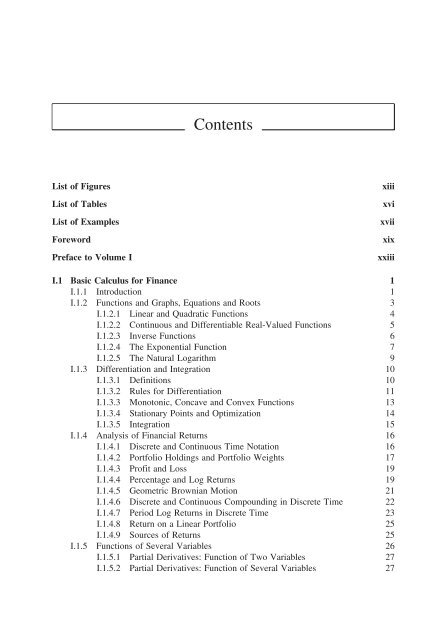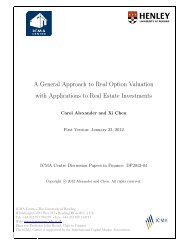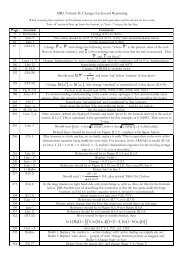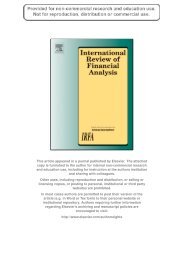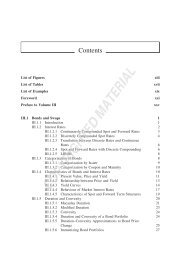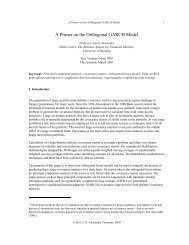Contents - Professor Carol Alexander
Contents - Professor Carol Alexander
Contents - Professor Carol Alexander
Create successful ePaper yourself
Turn your PDF publications into a flip-book with our unique Google optimized e-Paper software.
<strong>Contents</strong><br />
List of Figures<br />
List of Tables<br />
List of Examples<br />
Foreword<br />
Preface to Volume I<br />
xiii<br />
xvi<br />
xvii<br />
xix<br />
xxiii<br />
I.1 Basic Calculus for Finance 1<br />
I.1.1 Introduction 1<br />
I.1.2 Functions and Graphs, Equations and Roots 3<br />
I.1.2.1 Linear and Quadratic Functions 4<br />
I.1.2.2 Continuous and Differentiable Real-Valued Functions 5<br />
I.1.2.3 Inverse Functions 6<br />
I.1.2.4 The Exponential Function 7<br />
I.1.2.5 The Natural Logarithm 9<br />
I.1.3 Differentiation and Integration 10<br />
I.1.3.1 Definitions 10<br />
I.1.3.2 Rules for Differentiation 11<br />
I.1.3.3 Monotonic, Concave and Convex Functions 13<br />
I.1.3.4 Stationary Points and Optimization 14<br />
I.1.3.5 Integration 15<br />
I.1.4 Analysis of Financial Returns 16<br />
I.1.4.1 Discrete and Continuous Time Notation 16<br />
I.1.4.2 Portfolio Holdings and Portfolio Weights 17<br />
I.1.4.3 Profit and Loss 19<br />
I.1.4.4 Percentage and Log Returns 19<br />
I.1.4.5 Geometric Brownian Motion 21<br />
I.1.4.6 Discrete and Continuous Compounding in Discrete Time 22<br />
I.1.4.7 Period Log Returns in Discrete Time 23<br />
I.1.4.8 Return on a Linear Portfolio 25<br />
I.1.4.9 Sources of Returns 25<br />
I.1.5 Functions of Several Variables 26<br />
I.1.5.1 Partial Derivatives: Function of Two Variables 27<br />
I.1.5.2 Partial Derivatives: Function of Several Variables 27
viii<br />
<strong>Contents</strong><br />
I.1.5.3 Stationary Points 28<br />
I.1.5.4 Optimization 29<br />
I.1.5.5 Total Derivatives 31<br />
I.1.6 Taylor Expansion 31<br />
I.1.6.1 Definition and Examples 32<br />
I.1.6.2 Risk Factors and their Sensitivities 33<br />
I.1.6.3 Some Financial Applications of Taylor Expansion 33<br />
I.1.6.4 Multivariate Taylor Expansion 34<br />
I.1.7 Summary and Conclusions 35<br />
I.2 Essential Linear Algebra for Finance 37<br />
I.2.1 Introduction 37<br />
I.2.2 Matrix Algebra and its Mathematical Applications 38<br />
I.2.2.1 Basic Terminology 38<br />
I.2.2.2 Laws of Matrix Algebra 39<br />
I.2.2.3 Singular Matrices 40<br />
I.2.2.4 Determinants 41<br />
I.2.2.5 Matrix Inversion 43<br />
I.2.2.6 Solution of Simultaneous Linear Equations 44<br />
I.2.2.7 Quadratic Forms 45<br />
I.2.2.8 Definite Matrices 46<br />
I.2.3 Eigenvectors and Eigenvalues 48<br />
I.2.3.1 Matrices as Linear Transformations 48<br />
I.2.3.2 Formal Definitions 50<br />
I.2.3.3 The Characteristic Equation 51<br />
I.2.3.4<br />
Eigenvalues and Eigenvectors of a 2 × 2 Correlation<br />
Matrix 52<br />
I.2.3.5 Properties of Eigenvalues and Eigenvectors 52<br />
I.2.3.6 Using Excel to Find Eigenvalues and Eigenvectors 53<br />
I.2.3.7 Eigenvalue Test for Definiteness 54<br />
I.2.4 Applications to Linear Portfolios 55<br />
I.2.4.1 Covariance and Correlation Matrices 55<br />
I.2.4.2 Portfolio Risk and Return in Matrix Notation 56<br />
I.2.4.3<br />
I.2.4.4<br />
Positive Definiteness of Covariance and Correlation<br />
Matrices 58<br />
Eigenvalues and Eigenvectors of Covariance and<br />
Correlation Matrices 59<br />
I.2.5 Matrix Decomposition 61<br />
I.2.5.1 Spectral Decomposition of a Symmetric Matrix 61<br />
I.2.5.2 Similarity Transforms 62<br />
I.2.5.3 Cholesky Decomposition 62<br />
I.2.5.4 LU Decomposition 63<br />
I.2.6 Principal Component Analysis 64<br />
I.2.6.1 Definition of Principal Components 65<br />
I.2.6.2 Principal Component Representation 66<br />
I.2.6.3 Case Study: PCA of European Equity Indices 67<br />
I.2.7 Summary and Conclusions 70
<strong>Contents</strong><br />
ix<br />
I.3 Probability and Statistics 71<br />
I.3.1 Introduction 71<br />
I.3.2 Basic Concepts 72<br />
I.3.2.1 Classical versus Bayesian Approaches 72<br />
I.3.2.2 Laws of Probability 73<br />
I.3.2.3 Density and Distribution Functions 75<br />
I.3.2.4 Samples and Histograms 76<br />
I.3.2.5 Expected Value and Sample Mean 78<br />
I.3.2.6 Variance 79<br />
I.3.2.7 Skewness and Kurtosis 81<br />
I.3.2.8 Quantiles, Quartiles and Percentiles 83<br />
I.3.3 Univariate Distributions 85<br />
I.3.3.1 Binomial Distribution 85<br />
I.3.3.2 Poisson and Exponential Distributions 87<br />
I.3.3.3 Uniform Distribution 89<br />
I.3.3.4 Normal Distribution 90<br />
I.3.3.5 Lognormal Distribution 93<br />
I.3.3.6 Normal Mixture Distributions 94<br />
I.3.3.7 Student t Distributions 97<br />
I.3.3.8 Sampling Distributions 100<br />
I.3.3.9 Generalized Extreme Value Distributions 101<br />
I.3.3.10 Generalized Pareto Distribution 103<br />
I.3.3.11 Stable Distributions 105<br />
I.3.3.12 Kernels 106<br />
I.3.4 Multivariate Distributions 107<br />
I.3.4.1 Bivariate Distributions 108<br />
I.3.4.2 Independent Random Variables 109<br />
I.3.4.3 Covariance 110<br />
I.3.4.4 Correlation 111<br />
I.3.4.5 Multivariate Continuous Distributions 114<br />
I.3.4.6 Multivariate Normal Distributions 115<br />
I.3.4.7 Bivariate Normal Mixture Distributions 116<br />
I.3.4.8 Multivariate Student t Distributions 117<br />
I.3.5 Introduction to Statistical Inference 118<br />
I.3.5.1 Quantiles, Critical Values and Confidence Intervals 118<br />
I.3.5.2 Central Limit Theorem 120<br />
I.3.5.3 Confidence Intervals Based on Student t Distribution 122<br />
I.3.5.4 Confidence Intervals for Variance 123<br />
I.3.5.5 Hypothesis Tests 124<br />
I.3.5.6 Tests on Means 125<br />
I.3.5.7 Tests on Variances 126<br />
I.3.5.8 Non-Parametric Tests on Distributions 127<br />
I.3.6 Maximum Likelihood Estimation 130<br />
I.3.6.1 The Likelihood Function 130<br />
I.3.6.2 Finding the Maximum Likelihood Estimates 131<br />
I.3.6.3 Standard Errors on Mean and Variance<br />
Estimates 133
x<br />
<strong>Contents</strong><br />
I.3.7 Stochastic Processes in Discrete and Continuous Time 134<br />
I.3.7.1 Stationary and Integrated Processes in Discrete Time 134<br />
I.3.7.2 Mean Reverting Processes and Random Walks in<br />
Continuous Time 136<br />
I.3.7.3 Stochastic Models for Asset Prices and Returns 137<br />
I.3.7.4 Jumps and the Poisson Process 139<br />
I.3.8 Summary and Conclusions 140<br />
I.4 Introduction to Linear Regression 143<br />
I.4.1 Introduction 143<br />
I.4.2 Simple Linear Regression 144<br />
I.4.2.1 Simple Linear Model 144<br />
I.4.2.2 Ordinary Least Squares 146<br />
I.4.2.3 Properties of the Error Process 148<br />
I.4.2.4 ANOVA and Goodness of Fit 149<br />
I.4.2.5 Hypothesis Tests on Coefficients 151<br />
I.4.2.6 Reporting the Estimated Regression Model 152<br />
I.4.2.7 Excel Estimation of the Simple Linear Model 153<br />
I.4.3 Properties of OLS Estimators 155<br />
I.4.3.1 Estimates and Estimators 155<br />
I.4.3.2 Unbiasedness and Efficiency 156<br />
I.4.3.3 Gauss–Markov Theorem 157<br />
I.4.3.4 Consistency and Normality of OLS Estimators 157<br />
I.4.3.5 Testing for Normality 158<br />
I.4.4 Multivariate Linear Regression 158<br />
I.4.4.1 Simple Linear Model and OLS in Matrix Notation 159<br />
I.4.4.2 General Linear Model 161<br />
I.4.4.3 Case Study: A Multiple Regression 162<br />
I.4.4.4 Multiple Regression in Excel 163<br />
I.4.4.5 Hypothesis Testing in Multiple Regression 163<br />
I.4.4.6 Testing Multiple Restrictions 166<br />
I.4.4.7 Confidence Intervals 167<br />
I.4.4.8 Multicollinearity 170<br />
I.4.4.9 Case Study: Determinants of Credit Spreads 171<br />
I.4.4.10 Orthogonal Regression 173<br />
I.4.5 Autocorrelation and Heteroscedasticity 175<br />
I.4.5.1 Causes of Autocorrelation and Heteroscedasticity 175<br />
I.4.5.2<br />
Consequences of Autocorrelation and<br />
Heteroscedasticity 176<br />
I.4.5.3 Testing for Autocorrelation 176<br />
I.4.5.4 Testing for Heteroscedasticity 177<br />
I.4.5.5 Generalized Least Squares 178<br />
I.4.6 Applications of Linear Regression in Finance 179<br />
I.4.6.1 Testing a Theory 179<br />
I.4.6.2 Analysing Empirical Market Behaviour 180<br />
I.4.6.3 Optimal Portfolio Allocation 181
<strong>Contents</strong><br />
xi<br />
I.4.6.4 Regression-Based Hedge Ratios 181<br />
I.4.6.5 Trading on Regression Models 182<br />
I.4.7 Summary and Conclusions 184<br />
I.5 Numerical Methods in Finance 185<br />
I.5.1 Introduction 185<br />
I.5.2 Iteration 187<br />
I.5.2.1 Method of Bisection 187<br />
I.5.2.2 Newton–Raphson Iteration 188<br />
I.5.2.3 Gradient Methods 191<br />
I.5.3 Interpolation and Extrapolation 193<br />
I.5.3.1 Linear and Bilinear Interpolation 193<br />
I.5.3.2 Polynomial Interpolation: Application to Currency Options 195<br />
I.5.3.3 Cubic Splines: Application to Yield Curves 197<br />
I.5.4 Optimization 200<br />
I.5.4.1 Least Squares Problems 201<br />
I.5.4.2 Likelihood Methods 202<br />
I.5.4.3 The EM Algorithm 203<br />
I.5.4.4<br />
Case Study: Applying the EM Algorithm to Normal Mixture<br />
Densities 203<br />
I.5.5 Finite Difference Approximations 206<br />
I.5.5.1 First and Second Order Finite Differences 206<br />
I.5.5.2 Finite Difference Approximations for the Greeks 207<br />
I.5.5.3 Finite Difference Solutions to Partial Differential Equations 208<br />
I.5.6 Binomial Lattices 210<br />
I.5.6.1 Constructing the Lattice 211<br />
I.5.6.2 Arbitrage Free Pricing and Risk Neutral Valuation 211<br />
I.5.6.3 Pricing European Options 212<br />
I.5.6.4 Lognormal Asset Price Distributions 213<br />
I.5.6.5 Pricing American Options 215<br />
I.5.7 Monte Carlo Simulation 217<br />
I.5.7.1 Random Numbers 217<br />
I.5.7.2 Simulations from an Empirical or a Given Distribution 217<br />
I.5.7.3 Case Study: Generating Time Series of Lognormal Asset<br />
Prices 218<br />
I.5.7.4 Simulations on a System of Two Correlated Normal Returns 220<br />
I.5.7.5 Multivariate Normal and Student t Distributed<br />
Simulations 220<br />
I.5.8 Summary and Conclusions 223<br />
I.6 Introduction to Portfolio Theory 225<br />
I.6.1 Introduction 225<br />
I.6.2 Utility Theory 226<br />
I.6.2.1 Properties of Utility Functions 226<br />
I.6.2.2 Risk Preference 229<br />
I.6.2.3 How to Determine the Risk Tolerance of an Investor 230<br />
I.6.2.4 Coefficients of Risk Aversion 231
xii<br />
<strong>Contents</strong><br />
I.6.2.5 Some Standard Utility Functions 232<br />
I.6.2.6 Mean–Variance Criterion 234<br />
I.6.2.7 Extension of the Mean–Variance Criterion to<br />
Higher Moments 235<br />
I.6.3 Portfolio Allocation 237<br />
I.6.3.1 Portfolio Diversification 238<br />
I.6.3.2 Minimum Variance Portfolios 240<br />
I.6.3.3 The Markowitz Problem 244<br />
I.6.3.4 Minimum Variance Portfolios with Many Constraints 245<br />
I.6.3.5 Efficient Frontier 246<br />
I.6.3.6 Optimal Allocations 247<br />
I.6.4 Theory of Asset Pricing 250<br />
I.6.4.1 Capital Market Line 250<br />
I.6.4.2 Capital Asset Pricing Model 252<br />
I.6.4.3 Security Market Line 253<br />
I.6.4.4 Testing the CAPM 254<br />
I.6.4.5 Extensions to CAPM 255<br />
I.6.5 Risk Adjusted Performance Measures 256<br />
I.6.5.1 CAPM RAPMs 257<br />
I.6.5.2 Making Decisions Using the Sharpe Ratio 258<br />
I.6.5.3 Adjusting the Sharpe Ratio for Autocorrelation 259<br />
I.6.5.4 Adjusting the Sharpe Ratio for Higher Moments 260<br />
I.6.5.5 Generalized Sharpe Ratio 262<br />
I.6.5.6 Kappa Indices, Omega and Sortino Ratio 263<br />
I.6.6 Summary and Conclusions 266<br />
References 269<br />
Statistical Tables 273<br />
Index 279


